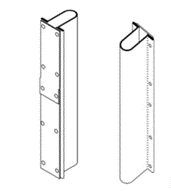December 20, 2022
This case is a reminder that, when considering whether a registered Community design is dictated solely by its technical function, the key word is “solely”. If there is any evidence of aesthetic qualities being taken into account by the designer, then the design will not be “solely” dictated by its technical function and could still qualify as a valid registered Community design.
Facts
In a registered Community design (RCD) case for security fence posts, as represented below, the General Court (GC) came to the view that the post design below was not solely dictated by function and so was not invalid.

The Board of Appeal (BoA), found that the evidence, which included a European patent application, was not convincing enough to prove that the features of appearance of the fence posts had been dictated by considerations other than technical ones. It had therefore concluded that the RCD had to be declared invalid in accordance with Article 8(1).
The applicant /appellant, Praesidiad Holding, , argued that the BoA had erroneously imposed features described in the patent application on to the RCD, which had led it to err in finding that the features of the RCD were solely dictated by the technical function of the fence posts.
Decision
The GC noted that the BoA was perfectly entitled to consider the patent application as part of its analysis. However, given that a patent application only explains the technical specificities of a product, it cannot automatically rule out the possibility that other considerations might also have been taken into account in the creation of the design.
The BoA had indeed considered other relevant materials, including expert opinions, the existence of other designs and the fact that the product in question is visible to the public, but found that they were insufficient to establish that anything more than technical considerations had played a role in the creation of the desisn.
The GC found that the expert opinions confirmed the important role that technical considerations had played in the design process. However, it said, they also referred to various visual matters that had been considered by the designer in the creation of at least two of the three features of the RCD, which the BoA had ignored. The GC noted that the application of Article 8(1depends on whether there is a total lack of non-technical considerations. In other words, an RCD can be created based on technical considerations as long as they were not the only considerations.
In the GC’s view, the expert opinions in fact showed the importance of aesthetic qualities in the design of security fence posts and referred to the actual features of the RCD to show the role they had played in its creation. Further, the GC noted that in Case T-515/19 Lego v EUIPO EU:T:2021:155, it was found that if at least one of the features of appearance of the product is not solely dictated by the technical function of that product, the design cannot be declared invalid under Article 8(1).
The GC also found that the BoA should not have excluded the evidence showing the existence of alternative security fence post designs, which were different in shape from the RCD in question. While such evidence could not be decisive on its own, the GC said, it was a relevant factor in this case that should have been considered.
Further, the GC held that the fact that a product is visible to the public, especially when it is a large product like a security fence post, is an important factor to consider. The expert opinions showed that when products are highly visible in their external environment on account of their size, the designer is led to consider how to make the product blend in with the environment so that it is as unobtrusive as possible. In other words, the designer would take into account the public’s perception of the product and the visual qualities of the fence post were an important factor in its design. In the GC’s view, this expert evidence constituted objective evidence of the existence of considerations other than technical considerations in the creation of the RCD.
The GC also said that the expert findings were supported by the catalogues, brochures and other marketing material submitted in evidence by Praesidiad, which confirmed that aesthetic aspects were important factors across the security fencing market in general. Consequently, the GC said, the fact that a product is visible to the public is one of the objective factors that prove that the features of appearance of the product have not been solely dictated by its technical function.
Accordingly, the GC held that the BoA had erred in finding that all the features of appearance of the contested design had been solely dictated by the technical function of the product.
The BoA’s decision was annulled and the application for a declaration of invalidity of the RCD was rejected. (Case T-231/21 Praesidiad Holding v EUIPO Eu:T:2022:649 (19 October 2022) — to read the judgment in full, click here).
Expertise